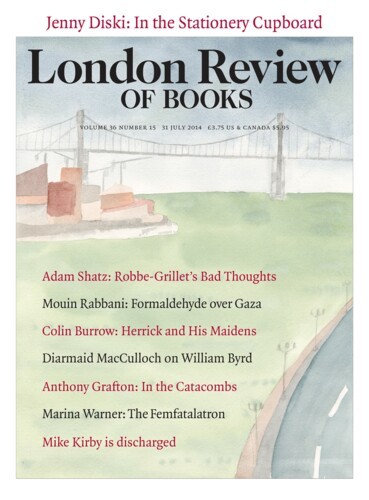What do moors sound like? Like a universe of bees, whose unison is only a few notes higher than the singing of our own bloodstream, which we half-hear, half-sense during the small hours between sleeps. What do they smell like? Like honey, steeping the sunshine. What do they look like? Like a brown and purple cloud-shadow spread out across the uplands, described by William Atkins in characteristically fine focus when he says of the North Yorkshire moors that ‘the new blooms were silverish specks; they were pale grey, beige and mint green. I picked a sprig, but the moor-purple visible from a distance was not a colour you could take home. That would be like hoping to capture a sea’s blue in a dunked glass.’
The sounds and smells I think of as moorland are those of Aberdeenshire, and Atkins doesn’t get that far north. His beat is from Bodmin Moor in eastern Cornwall via Dartmoor, the Peak District and the Calder Valley to north-east Yorkshire and the Borders at Otterburn. Endearingly, his native moor was not even a moor at all, but a fen scattered with carrs, the sourceland of the Hamble, south-east of Winchester, where as a boy he went, often alone, sometimes with his father, to watch and photograph the deer and kingfishers and herons when they broke cover.
So that is where this book welled up and spread outwards, in ‘a kind of reply to the portion of myself that remained uncultivated’. These great uprisings of nature – beyond the cities and the villages, cleft by roads, quarried and mined, burned over to nourish grouse for the guns, fenced off by missile-tracking stations, pounded by military shells – exert a massive, quiet pressure which was once actual: the upward surge of molten granite created the batholith which surfaces at Dartmoor, Bodmin, West Penwith and Scilly. Without such landscapes England would be wholly civilised, a terrain transmuted and fine-tuned for the making of livelihoods. To be sure the moors, too, are worked for human advantage, whether to provide stone for prisons (at Princeton or Peterhead), or lead for piping (at Nenthead in north Cumbria), or fodder for wild animals ‘preserved’ to be shot as game, or used as wasteground on which tanks and artillery can try out their machinery of destruction. The moors continue to assert their otherness, whether you are splashing through the rusty pools of Dartmoor, marvelling at the extent of Sutherland, where the rivers look as though they might well have risen in Tibet, or passing slowly through the massifs of the Cairngorms, where the moors are a shallow quilt of peat and heather clinging onto the colossal rock-forms of the mountains.
The beauty of The Moor is that it sees our shaggy and stony uplands as wholly entangled in human life, not as weird lunar nowherelands. In 1681 Charles Cotton dismissed them as ‘Nature’s pudenda’; in 1775 Dr Johnson was ‘astonished and repelled’ by their ‘wide extent of hopeless sterility’ (though he at least had the hardihood to go and see them for himself); in 1826 Noel Thomas Carrington accused them of ‘shaming the map of England’ with their barrenness. Such was the outsider’s or townsperson’s notion of the moors, expanded to a visionary plane by Shakespeare in Macbeth and King Lear. The weather on the heath is, naturally, atrocious, fraught with thunderstorms and tornadoes, and it’s peopled by wandering madmen and by witches whom its earth and ‘foggy cloud’ secrete like bubbles. In King Lear, supremely, the elemental force of such places, ‘the to-and-fro-conflicting wind and rain’, is conjured up by the crazed king as a polar opposite of the human elements that have turned against him.
For Atkins, the moor isn’t a barbarous antithesis of our human selves, or the idyllic place envisaged in the sublime last sentence of Wuthering Heights, when our troubles and disquiets have been laid to rest amid ‘moths fluttering among the heath and harebells’ and ‘the soft wind breathing through the grass’. He has frequented the moors through printed records as well as his own explorations, and in story after story he brings us close to the motley human lives that have been at home there. He tells the story of Charlotte Dymond, a farm servant at Penhale on the north edge of Bodmin Moor, whose throat was cut by her workmate Matthew Weeks in 1844 (several thousand people turned up to watch him hang); and of Christopher Atkinson, vicar of Danby in Cleveland, who walked 140,000 miles to visit his parishioners and to carry out his own investigations. Atkinson wrote an observant account of his moorland charges (with chapter headings like ‘Bee Customs and Notions’ and ‘Calf Burying’) while he was minister of a church whose font was like a ‘paltry slop-basin’ and whose organ-stop couplers had been eaten through by mice.
Atkins is not a connoisseur of the outlandish. The histories he has pieced together of each moor amount to thorough and beautifully detailed chronicles of fundamental developments in our countryside. At one point he surveys the evolution of the moors from the retreat of the glaciers through the shrinking of forests to the forming of peat and the moorland’s present condition as ‘a harsh place for summer grazing, cultivated for crops only by the extravagant, stubborn or desperate’. At another, he tells us exactly what the Fylingdales ballistic missile early warning system (BMEWS) was built for, along with its counterparts in Thule in Greenland and Clear in Alaska: to give the US twenty minutes’ warning of incoming Soviet missiles and the UK four – ‘the system’s efficacy would only be proven when the country was already an irradiated slagheap.’
Although he takes us where necessary into these contentious areas, he never blusters or hectors. He is a fine reporter, not exactly impartial, letting the details speak for themselves. The moor near Saddleworth, just south of the M62, inevitably features the Moors murderers. Ian Brady is defined with characteristic justice as ‘pouting, imperious’, with a ‘facility for barbarism’. The land round Fylingdales is pocked with craters left by artillery exercises which are now rife with tadpoles and newts, while the moor supports fox and crow and peregrine because it has been ‘spared the shoot and the dogs, the managed burn, the swiping, the keepers’ constant ministrations’. Atkins is as even-handed – as attentive to the real world in its fine detail – in his treatment of the ways we have ‘improved’ wild land as he is in his evocation of its original state. You could, if you wanted, use The Moor as a guidebook and be led by it along a hundred paths and tracks. On Alston moor:
I went east along the moor edge, passing alongside another small plantation, redolent with pine scent and, inside, as lifeless as a derelict warehouse … The land was scattered with lead-mining shafts, indicated by ring mounds, turfed calderas ten feet across … being made of upthrown limestone [they] supported a greener, more succulent grass, and sheep were often loitering on them as I approached.
The prose is careful and inventive – ‘calderas’ – and only once lurches into a conceit, when a lapwing is likened to ‘a paperback blasted from a cannon’. He is not writing to show off at the expense of the material; he is writing to be clear about the plethora of observation, history and science we need if we are to know the moors.
Like the ground under its feet, the book is a little uneven. Bodmin Moor and Exmoor came over to me rather more in scraps than as wholes, and Dartmoor is oddly treated, with a lot of space spent on Atkins’s sojourn at Buckland Abbey, where he ‘attended each of the abbey’s offices, the horarium – Matins at 5.45 a.m., Lauds an hour later, Mass at 8 a.m., Compline at 9 p.m. – and breakfast, lunch and dinner in the vaulted refectory, while a novice wearing a headset microphone read from a biography of Dickens.’ It would have been good to have more of the thing itself. When I walked from Ivybridge in Devon the 32 miles north to Okehampton, I was deeply struck, and gruelled and weighted down, by the tracts that rippled away on all sides: purple moorglass glistening with a silvering of condensed fog, pools where we had to balance from one tussock to another between clumps of orange sphagnum, contours so gradual that I pined for landmarks. After sunset ‘civilisation’ was at last on hand – some miles of tarmac laid down by the military – and this was torture, because I had long since taken off the borrowed boots that had flayed the skin off both heels and was walking in socks (three pairs). In the darkness, time after time, unseen gravel chips drove like nails into my soft footsoles.
The whole thing had encapsulated what I had come to realise after many years of hill-walking, that the moors are formidable, exacting, but they have a human scale. Atkins tells the story of Frank Elgee, a museum curator in Middlesbrough and the author of The Moorlands of North-East Yorkshire. He had been deafened by scarlet fever and pneumonia had ruined half a lung. Wheeled about in a bathchair by his mother, he looked intently at redstarts and peacock butterflies. When he was able to struggle through the peat haggs himself, he wooed Miss Harriet Wragg BA, who recalled ‘watching him, diminutive, frail as a plant, standing at the base of a hard, rocky cliff, his white hand resting on its face as it might rest caressingly on the face of his wife, and I knowing that he loved four hundred square miles of moorland with the same reverent intimacy.’
Send Letters To:
The Editor
London Review of Books,
28 Little Russell Street
London, WC1A 2HN
letters@lrb.co.uk
Please include name, address, and a telephone number.


